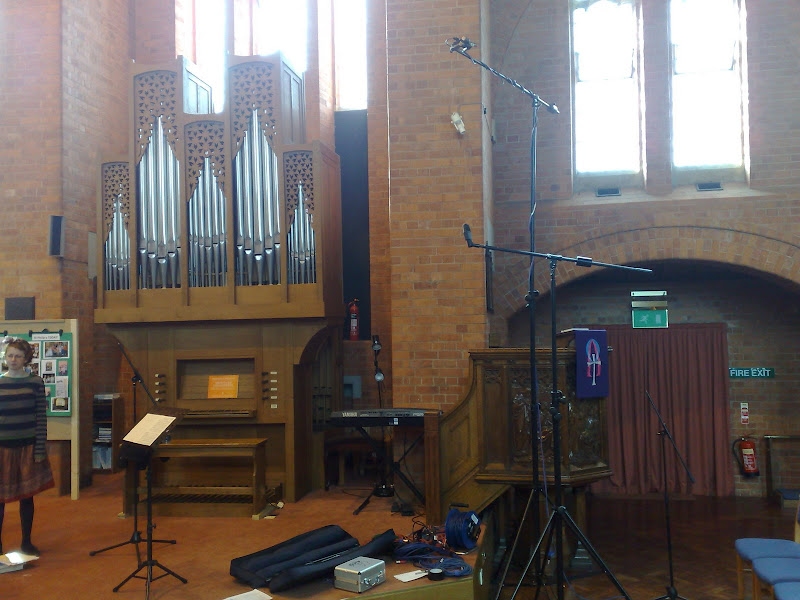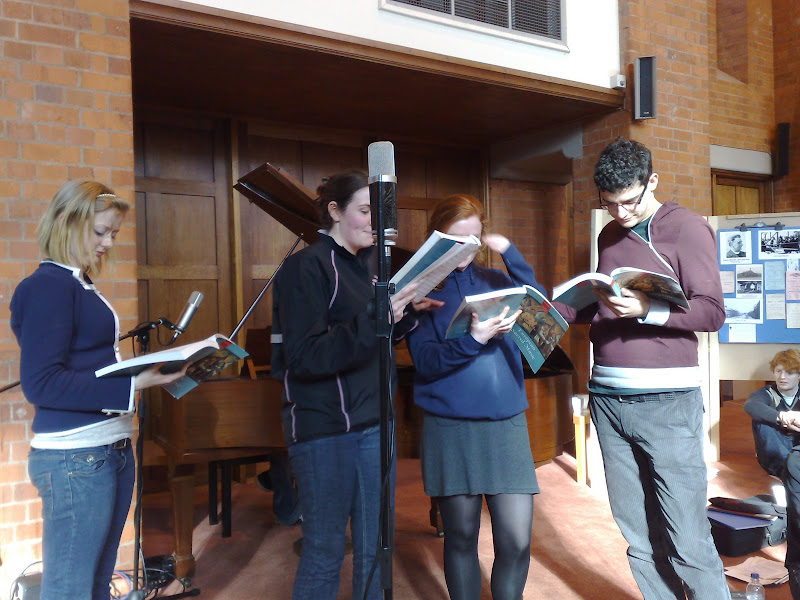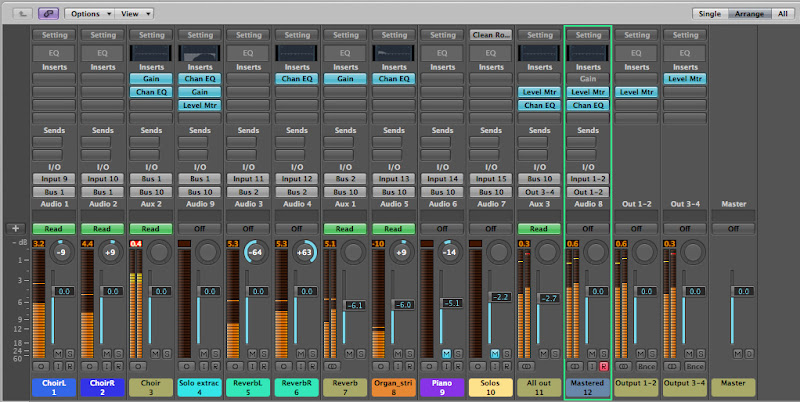IntroLast Saturday I went to St Philip's Church in Leicester to record a joint concert of Fitzwilliam College Choir and St Edmund's Hall Choir.
The venueThe church is quite large (to seat about 150-200 people easily) witch wooden arc-shaped ceiling, soft seats and carpet floor. This causes the acoustics to be really dry for this sized space. I was very happy with it though, because it gave nice and soft sound.
PerformersOver the course of the concert, the following appeared: Choir, organ, piano, string quartet, instrumental trio (organ, recorder and bassoon) and soloists. Unfortunately, when I was arranging the equipment and microphones for the event I was only aware of the choir, soloists and organ. Therefore I had to split the NTKs that I wanted to use as a stereo pair for soloists and use one of them for the piano. Luckily, the string quartet, bassoon and recorder were placed next to the organ and rarely playing together, so I could use one microphone for them all. It didn't come out as best set-up ever, but given the equipment I had it was the best I could do.
Detailed microphone set-upFor the main choir, I used a crossed pair of AKG C414s both set as cardioids, placed as close to the middle as possible without interrupting the conductor, to his left. I extended it up high just above his head so that it wouldn't interfere. Here are pictures:




Unfortunately, I couldn't place the reverb microphones (Røde NT5s – their small diaphragm would not pick up too much of noise rumble from the street, plus I have seen them in action as reverb microphones and they did excellent job) on the middle of the church simply because the boom microphone stand that I wanted to use is too bulky to be put right in front of the choir. Therefore, I put it as close to the middle as I could, extending the arm as long as it goes. Eventually I reached the place a couple of meters from the middle, approximately in the middle of the total height of the church. After some struggling up with the handles, I managed to set them up as a wide spread stereo pair. Here is how they looked like:





For the organ and other instruments I used another C414, but this time set up as a hypercardioid for it to concentrate only on the area where the instruments were. There was nothing behind it to spoil the effect. It was sitting on another boom stand, extended so that it would be almost above the instruments, facing downwards a bit (about 45 degrees):

The soloists were miked up using one of the Røde NTKs, placed on the height of their mouths, approximately 1.5 metres away from them. I instructed them to make a sort of semicircle so that the difference in their distances from the microphone would be minimal:

I placed another NTK by the piano. The instrument sounded a bit out of tune and very, very dump. To get the most of the (virtually non-existent) sharp attack, I placed the microphone facing the hammers section of the piano:



All above microphones were sent through a multicore to the room on the back, where the mixing desk and noisy recorder were. I used the kit that was freshly put together in ARU studios, consisting of Yamaha DM1000 desk and Fostex DV242LV. I chose to record in 24 bit resolution, 48 kHz sampling rate.
 Hello!
Hello! Program:
Program:- Beati Quorum Via – C V Stanford, choir only
- Like a Hart – H Howells, organ and choir
- Ubi Caritas – M Duruflé, choir only
- Haec est Regina Virginum – G F Handel, soprano and piano
- O my deir Hart – H Howells, soprano and piano
- Prelude in E – BuxWV141 – D Buxtehude, organ
- Let all mortal flesh keep silence – E Bairstow, choir only
- Ave Verum Corpus – W A Mozart, choir only
- Missa Brevis in G – W A Mozart, choir, organ and strings
INTERVAL
- Cantique de Jean Racine – G Fauré, choir and piano
- Sonaten in B flat – G P Telemann, recorder, bassoon and organ
- Bogoroditse Devo – S Rachmaninoff, choir only
- Miserere – G Allegri, choir and 4 soloists
- Praeludium in e – Nicolaus Brühns, organ
- Loveliest of Trees, Is my team ploughing – G Butterworth, tenor solo and piano
- Whither must I wander – R V Williams, tenor solo and piano
- Blessed be the God and Father – S S Wesley, choir and organ
Notes taken during recording:- Piano sounds very wet and dump, no attack. Will have to be heavily EQ-ed.
- There is no clipping on any of the microphones during applause.
- There was a slight clip during Like as the Hart on organ track.
- Another one happened during Haec est Regina Virginum on soloists microphone. Levels taken down as soon as possible on both tracks.
- During Ave Verum Corpus, a table was moved in the far part of the church by one bored person who was selling tickets before. May cause problem.
- For instrumental trio, it will be good to use the choir microphones.
- There might be a clip on one of the reverb microphones during Miserere. Weird.
- Both tenor soloists were moving around a lot and didn't care to stand close to the microphone – they were right 90 degrees from its front – picked up plenty only some of them singng, will be very hard to edit. Preferably find another microphone to use.
- Organ microphone picks up a lot of choir, to be remembered when mixing.
- During last piece, soloist was standing together with the choir. Recommended to fiddle with pan width for solos / choral parts.
First Logic sessionThe first thing to do was to get the whole record from Fostex to Logic. What appears to be a simple task (just plug the Fostex optical output to the MOTU Firewire interface optical input), came out much harder. With some help from the studio technician, we finally managed to sync the clocks of Fostex, computer and MOTU, only to realise that all the recorded voices sound like everyone inhaled helium. After some more experimenting with clocks and sample rates we realised that although I am sure that I've done the recording with 48kHz sampling rate, the transfer between Fostex and MOTU only works properly when the sample rate on both of them is set to 44.1kHz. Therefore, to my disappointment, I now have the whole project in lower sampling rate than I was expecting. Still, the resolution is high – 24 bits, and after first listen to the record I am fully satisfied with the quality.
While writing all of the above, I was at the same time listening to the whole concert, searching for odd sounds and clipping. Also, I cut almost the whole record into piece-long regions. To make my first mix easier, I applied slight compression, mainly to increase overall levels. Some screen-shots (click to enlarge):


 How does it sound?The choir:
How does it sound?The choir: Even stereo spread, natural and balanced sound. This pair also picked up a lot of organ and soloists, and obviously piano, which apparently has been picked up by all microphones.
Reverb: Wide stereo spread, sounds better than any Space Designer. No rumble, and very clear top.
Organ / strings: Thanks to hypercardioidal characteristics, it picked up a lot of organ and strings, even though the choir was very close. There is still a lot of choir present, but considering that they appear together rather rarely, it shouldn't be a problem when mixing. This microphone picked up a lot of organ keyboard sounds, but I think it will sound natural if I keep them in the mix. String sound natural and are clearly distinguished from the organ even when they play together – I guess that's because of good microphone positioning (directed towards strings, but still close to organ).
Soloists: Except for tenor pieces, where they didn't stand on the front of the microphone, NTK provided crystal-clear quality. Because soloists were standing right in front of the piano, their microphone picked a lot of it, but thanks to another microphone for the piano, it should be easy to separate them in the mix.
Piano: The instrument itself sounded, as I said before, very dump. there was virtually no attack to the notes and very little bottom. All of the content oscillated around 500Hz-2kHz and will have to be EQed to get it to sound nice. It might cause problem when mixing with reverb microphones which are full of it. This channel contains barely other sounds but the piano.
Problems found in the materialThere was little amount of coughs and squeaking chairs. This all I think I will have to live with, although while going through the record I plan to reduce these noises as much as I can. I found one big thing though, and I am not sure where did it come from. On one of the reverb microphones (which eliminates someone hitting the stand, which would affect both of the microphones), there was a sudden 'pah' sound which peaked and clipped the signal for a half a second:

Because it basically looks like a massive, but single low frequency ripple, I used EQ with a steep (48dB/oct) bass cut below 196Hz, which reduced the '
PPAH' to little '
p':

There was also a little bell-like sound on the reverb microphones some other time, I will try to get rid of it somehow.
Summary
That's it for the first session. I am very happy with the raw material. I believe that the choral parts sound almost perfect with barely any mixing, and other pieces will require only slight interventions - a perfect example of recording well done from the beginning.























































